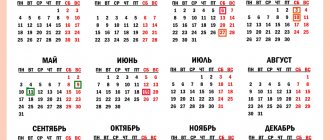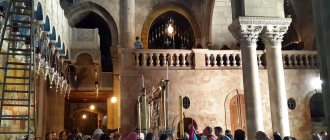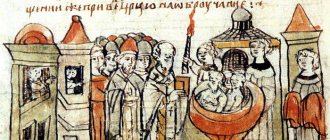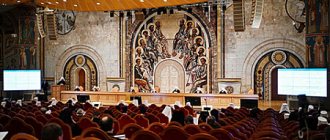In the bustle of days, a person usually rarely thinks about death. As a result, when the time comes, we often do not know how to see off a loved one on their last journey.
This leads to the fact that the relatives of the deceased do not understand what needs to be done in order for his soul to find peace in another world.
In addition, there are still many superstitions that Orthodox Christians should not follow during funeral rites. Not everyone knows about this and understands the danger they pose for a believer.
In preparation for the funeral, the dying person is given communion and the “Canon of Prayerful Exodus of the Soul” is read over him.
An Orthodox Christian should not die without realizing the fact that his earthly life will soon end.
Many relatives of sick people who are about to die try, out of good intentions, to hide the truth from them. As you know, the road to hell is lined with good intentions. By doing this, such people only show their cowardice, giving their loved one an illusory hope of recovery.
Before death, an Orthodox Christian must confess and receive communion.
If they care about him, on the contrary, they must tell him the truth in order to have time to take care of the dying parting words, as well as call the priest to the dying man. The latter is done only with his consent.
It is prohibited to give communion to persons who are unconscious or unconscious, so the priest is invited in advance. Naturally, it will not be possible to hide the truth about imminent death in front of a dying person, and if you do not invite a priest, then he will die without repentance and communion.
Mosaic-composition-of-the-Eucharist-in-the-Church-of-the-Intercession-of-the-Blessed-Theotokos-in-Yasenevo-city. Moscow
By receiving communion, a person unites with the Divine. It is especially important to do this before heading to another world, because during Communion the body of Christ becomes our body and the Blood of Christ begins to flow in our veins.
Many priests note that a large number of even believers, when preparing a loved one for death, attach great importance to external attributes. This is not correct, since it is important not to bury a person “correctly,” but to prepare his death so that it is Christian.
The main goal of earthly preparations is for the human soul to appear before the Lord pure and sinless.
This can only be done at confession and by communion of the Holy Mysteries of Christ. Without this, the Orthodox funeral rite will lack full meaning.
Venetsianov A.G. Communion to the dying. 1839 In Russia, the ritual of giving communion to the dying has always been strictly observed.
As people who have experienced clinical death testify, when the soul is separated from the body, a person usually experiences some kind of mental anguish. Many confirm the fact that they are unclean spirits in terrible forms. Their terrible voices can also be heard.
In order to facilitate the transition of the human soul to eternity, a special prayer called “The Canon of Prayer for the Exodus of the Soul” is usually read over the dying person.
If external paraphernalia is important for loved ones, then they should know that holy water and antidoron can be given to a conscious person who is dying, subject to the requirements for confession and communion.
How to behave at a wake after a funeral
The wake completes the burial procedure. Usually those who come to them are those who were invited by the relatives of the deceased. This is no accident: lunch is ordered in a cafe or prepared at home, focusing on the number of guests. Quiet conversations are common at the table - memories of someone who is no longer in this world. Those present can speak with a kind word in front of everyone or limit themselves to a conversation with those sitting nearby.
At the end, everyone is given candy, cookies, and pies. It is not accepted to refuse them. The deceased is remembered with food.
For all questions, call 48-00-64 ROUND THE CLOCK
Calculate the cost of a funeral
After death, the deceased is washed and the Psalms are read over him
In Orthodoxy, funerals take place on the third day. After the death of an Orthodox Christian, his body must be washed with warm water.
In this case, you need to read either the Trisagion or “Lord, have mercy”
Since the relatives of the deceased are already traumatized by his death, it is better for outsiders to perform this operation.
See also the article Why you can’t cry for a dead person in Orthodoxy
After the ablution of the deceased is completed, the reading of “Sequence on the exodus of the soul from the body” begins.
The order of all actions will be determined by the priest invited to the funeral service. In the same case, when he was able to arrive, prayers for the deceased are read by his relatives and friends.
Olga Kalashnikova. Novice (reading the Psalter). Not only relatives, but also those people who have received the blessing of the priest can read it next to the coffin of the deceased
Then they continue to read the Psalter. This must be done continuously before removing the body and if possible.
Unfortunately, in our time it is almost impossible to read for such a long time, so it is necessary to read the entire Psalter at the tomb at least once.
The hymn is read every day until 40 days have passed.
It is worth reading to the loved ones of the deceased themselves, since they can, at the same time, themselves receive consolation from the Lord.
If this cannot be done, it is necessary to ensure that the Psalms are read by those clergy who have the blessing of a priest to do so.
Ablution
At this stage, the deceased meets death. The person is washed, combed, and dressed in clean clothes.
On Russian soil, strangers were specially invited who could help the deceased appear before God pure in both soul and body. It would be better if these were people who were not burdened with sins themselves, for example, bachelors or widows. But in the absence of such, at least they are not relatives.
They believed that it would be harder for the soul of the deceased to leave the world if tears were shed for him.
Water after ablution was considered dead, and it had to be taken out of the house and poured, for example, into a ravine. And break the dishes themselves. This was done in order to break the connection with the deceased, so that he could not return to the world of the living and would not disturb them with his invisible presence.
Clothes for the deceased to be placed in the coffin are chosen at the discretion of the relatives
Before placing the body of the deceased in a coffin, it, as well as the coffin itself, is sprinkled with holy water. In addition, the coffin is also sprinkled inside and outside, and incense is burned. This is not necessarily done by a priest, but by any Christian.
When choosing clothes for burial, the relatives of the deceased should be guided by their preferences. In this case, it is necessary to take into account the worldly status of the deceased. For example, military personnel and special services personnel must be laid in the coffin in their uniform.
Laymen are usually placed in it in civilian dress. When choosing clothes, preference is usually given to those clothes that fit comfortably on the body of the deceased.
Dead man's clothing for men
When choosing it, you must give preference to classic, strict things that can easily be put on the deceased.
Very often relatives ask the question: what is needed for a woman’s funeral? Here the same requirements are presented to deceased men. At the same time, the requirement that women's clothing for the deceased must be modest and appropriate for the season must be observed.
In any case, dresses with a deep neckline, with inscriptions, decorations or any designs are prohibited.
Traditionally in Orthodoxy, the deceased is covered with a shroud or church veil. It is a cloth that is placed on the body. Usually the shroud is purchased at the temple. It is mandatory for the deceased to wear a pectoral cross.
In the case where the baptismal cross has been preserved, they put it on. A corolla is placed on the forehead of the deceased - a paper ribbon with an image of the image of the Savior, the Mother of God and John the Baptist printed on it.
Burial of Christ. Karl Heinrich Bloch. The Orthodox burial rite has many elements symbolizing the burial of Christ
There are rules according to which it is necessary to fold the hands of the deceased. They are placed on the chest, with the right hand placed on top of the left. A funeral cross or a small icon is placed in the left hand. An icon is placed on the chest. Men correspond to the Savior, women - the image of the Mother of God.
How will you appear before God?
Clothes were also given great importance. In Rus', for a certain period of time, these were white robes, but then the custom changed somewhat. Sometimes, when choosing an outfit, they adhere to the wishes expressed by the deceased during his lifetime. And even now, old people, often foreseeing their end, prepare their own funeral items.
It is customary for unmarried girls to be buried in wedding dresses. And it is important that the deceased’s shoes are comfortable and do not press, which is why the expression “white slippers” came into being. These are special shoes offered by a funeral service institution, which are made exclusively for the deceased.
“Funeral services in absentia” are prohibited, and music at an Orthodox funeral is inappropriate
The coffin is placed in compliance with different traditions, since no rules have been established for this. Usually it is installed according to tradition, placing the deceased, facing the east or towards the icons.
At the same time, it is necessary to avoid pagan superstitions and not light a candle in front of a photograph of the deceased or place a glass of water in his room.
In the room where the coffin stands, candles and lamps must be lit in front of the icons.
Before taking the deceased out of his house, it is advisable that his relatives invite a priest to perform a memorial service for him. The priest can also accompany the coffin to the temple, where the funeral service will take place.
The funeral service must take place in a church; funeral services in absentia are prohibited and can only be permitted in exceptional cases. Such an exception could be, for example, the absence of a temple in a particular area.
Contrary to existing superstitions, the coffin should be carried by relatives and close friends of the deceased. It is worth noting separately that a priest should under no circumstances carry a layman’s coffin. No exception is made here.
Transfer of the relics of St. Nicholas from Myra in Lycia to Baria
Even in ancient times, the coffin of the deceased had to be carried by his relatives and friends, which is depicted on the fresco.
When an Orthodox person has died, there is no need to invite an orchestra for his burial, since this does not correspond to church canons. When the soul is separated from the body, it is necessary to pray for it, but music distracts from this. For the same reason, you cannot talk loudly or cry during a funeral.
Directly at the cemetery, saying goodbye to the deceased, you will need to kiss the aureole on his forehead, as well as the icon lying in the coffin. During the funeral ceremony, you do not need to talk a lot or loudly. It is enough to say a few words about who the deceased was to you, to ask him for forgiveness for all the insults you caused him.
In addition, it is also necessary to forgive him for his offenses caused to you.
The coffin with the body is lowered into the grave with its head facing the East. This means that we are awaiting the Second Coming of Christ. The deceased goes from the West, that is, from the end of life to the East - eternity.
The cross in Orthodoxy is a symbol of salvation, so it is installed on the grave mound at the feet of the deceased
An eight-pointed cross is installed above the grave mound as a symbol of salvation. It can be made of any material and must have the correct shape. Place the cross at the feet of the deceased.
The crucifix should be directed towards his face, so that when he rises from the grave, he can look at the sign of Christ’s victory over the devil. The same rule applies to any monuments with crosses placed on them.
Funeral procession
As customs say, if a funeral procession passes by your house, you cannot have anyone sleeping in the house. They say that a dead person can drag a sleeping person with him. You can’t look out the window at the procession; it’s better to close the curtains and be in silence. You cannot cross the path of a funeral procession. It is believed that if the deceased was sick, the person who crossed the road can take his illness for himself. The day of the funeral is very difficult and painful, but it must be done correctly, no matter what. It is important to follow all the rules, hold a memorial dinner and pay tribute to the deceased. Some people firmly believe in these signs, while others consider them superstition. You are free to decide for yourself.
Read: This is why Tibetan Mahatmas and all beautiful women drink hot water in the morning
(No ratings yet)
Similar materials: loved one, last, life, don’t do, you can’t, bad, seeing off, path, burial, person, this
The burial of a priest is longer and more solemn than that of a lay person.
In Orthodoxy, priests are buried according to special rules. The main difference between this and the burial of the laity is that the rite is more complex and solemn. So, for example, five readings from the Apostle and five from the Gospel are read, and troparia are sung.
The buried priest dresses in his usual clothes. Next he is dressed in priestly attire.
Farewell to Alexy II takes place in the Cathedral of Christ the Savior, the funeral will take place in the Epiphany (Elokhovsky) Cathedral. Covered with air - an embroidered scarf, the face of the patriarch indicates that during his life he consecrated gifts and partook of the Holy Mysteries of God
Many laity have a question: why are priests buried with their faces covered? Indeed, the face of the deceased is covered with air, that is, with an embroidered scarf, which is usually used to cover the Holy Gifts during the liturgy.
A closed face means that now the clergyman stands before the face of the Lord and is closed to the world. He descends into the ground with the deceased and means that during his lifetime he was the performer of the Mysteries of God. The Gospel and the Cross are also placed in the hands of the deceased.
During the burial of a priest, the coffin with his body is carried three times around the temple in which he served. There is also a special chime. The burial rite for deacons, priests and bishops is different. This is worth remembering when watching it from the outside.
Funerals and ceremonies
“The Orthodox Church guides its children into the afterlife with the sacraments of Repentance, Communion and Blessing of Anointing, and in moments of separation of the soul from the body, it performs a canon for the exodus of the soul. It is read “on behalf of a person who is separated from his soul and cannot speak,” and is otherwise called the prayer of departure. At the moment of death, a person experiences a feeling of languor. When leaving the body, the soul meets the Guardian Angel given to it in Baptism and evil spirits - demons. The appearance of demons is so terrible that at the sight of them the soul is troubled and trembles.
The canon on the outcome of the soul in the absence of a priest should be read by the relatives or friends of the dying person.
If a person suffers long and hard and cannot die, then relatives can read another canon - “The rite performed for the separation of the soul from the body, never a person suffers for a long time.” Both of these canons are in the complete Orthodox prayer books.
Preparing the deceased for burial
The human body, according to the Church, is the temple of the soul, consecrated by the grace of the sacraments. According to the words of the holy Apostle Paul: “This corruptible must put on incorruption, and this mortal must put on immortality” (1 Cor. 15:53). Therefore, since apostolic times, the Church has lovingly cared for the remains of deceased brothers in faith. The image of the burial of the dead is given in the Gospel, which describes the burial of our Lord Jesus Christ. The Orthodox ritual of preparing the body of the deceased for burial has been preserved since Old Testament times and is expressed in washing the body, dressing it, and placing it in the coffin.
Washing the body with water foreshadows the future resurrection and standing before God in purity and immaculateness. When washing, you should read the Trisagion: “Holy God, Holy Mighty, Holy Immortal, have mercy on us,” or simply “Lord have mercy.” You need to wash your entire body with warm water and soap. According to tradition, ablution is performed by one of the relatives of the deceased.
The body of a Christian is dressed in new, clean clothes of light colors. In some regions of Russia, the deceased, in addition to ordinary clothes, is dressed in a shroud - a white cover reminiscent of the white clothes of baptism. The deceased must wear a pectoral cross. The washed and clothed body is placed on a prepared table face up, towards the east. The lips of the deceased should be closed, hands folded crosswise on the chest (right over left) as a sign of faith in the Crucified Christ. An icon of the Savior or a Crucifix is placed in the hands.
Pregnant women should not wash the deceased to avoid illness in the unborn child. Women who are menstruating should not wash the deceased. Previously, as a rule, only elderly women prepared the deceased for his last journey.
Before placing the body, the coffin is sprinkled with holy water, and you can cover it with incense.
The forehead of the deceased is decorated with a halo, which symbolizes the crown of the Kingdom of Heaven. The Apostle Paul said: “And now there is laid up for me a crown of righteousness, which the Lord, the righteous Judge, will give to me on that day; and not only to me, but also to all those who loved His appearing.” The Savior is depicted on the aureole with the Mother of God and John the Baptist standing before Him. The whisk is sold in the church; it is better to purchase it before the funeral and bring the deceased to the funeral service with the whisk.
A pillow is placed under the head, usually made of cotton wool or dry grass. There is a pious custom of preparing one’s “mortal pillow” in advance, filling the pillowcase with willow branches and birch leaves consecrated in the temple (this consecration occurs on Palm Sunday and on the day of the Holy Trinity, respectively).
The body is covered with a sheet or a special funeral shroud with the image of the Crucifixion - as a testimony to the faith of the Church that the deceased is under the protection of Christ.
The coffin is usually placed in the middle of the room in front of the icons. Candles are lit around him; if possible, then place four candlesticks: one at the head, another at the feet and two on both sides of the coffin; together they form a cross and symbolize the transition of the deceased to the Kingdom of true light.
It is forbidden to place any objects, money, or food in the coffin, since such customs are relics of paganism.
It is clear that the above rules can only be observed if the body has not been taken to the morgue. According to existing Russian standards, without submitting the deceased for an autopsy, it is impossible to obtain death certificates. Because of this, Orthodox people have to give their dead to the morgue for far from pious actions. This is very unfortunate, but every effort should be made to ensure that the body is properly prepared after it is released from the morgue.
Prayer for the deceased before the funeral service
Immediately after washing and vesting the deceased, the priest (or one of the relatives) reads a canon called “Sequence on the departure of the soul from the body” from the prayer book. If a person died not at home, then the canon must still be read on the day of death.
“Following” is read on behalf of the deceased with the purpose that God’s mercy, through our prayer for the deceased, will ease his soul the bitterness of separation from parting with the body. It ends with the prayer “Remember, O Lord our God, in faith and hope the eternal life that has passed away...”, which can be read separately from the canon.
Reading the psalter for the departed
In the Orthodox Church there is a custom of reading the Psalter over the body of a deceased layman before burial (the Psalter can be purchased at the church). It is best if reading is done continuously, day and night. Any pious layman can read the psalter. Households and relatives of the deceased should, as far as possible, join the prayer of the reader with their prayers. Of course, several people are needed for continuous reading.
The reading of the Psalter is done standing, and only in special cases is sitting allowed out of leniency for the weakness of the reader. As you know, the Psalter is divided into 20 kathismas, each of which, in turn, is divided into three parts - “Glories”. When reading for the repose, after each “Glory,” the above-mentioned prayer from “Following the Exodus of the Soul” is said with the name of the deceased, to which is added the word “newly deceased” (the Church considers a person to be such within forty days after death). A child under 7 years of age is called a “baby.” The use of other qualifying names, such as: maiden, youth, wife, warrior, killed, drowned, burned, etc., have no canonical basis and are not found in liturgical books.
Not without reason and not without purpose, since ancient times the Church has laid down the book of psalms to be read over the tomb of the deceased. The Psalter reproduces all the diversity of movements of our soul, so vividly sympathizes with both our joy and our sorrow, sheds so much consolation and approval into our grieving heart.
Memorial service
It is very good on all days preceding the burial to order memorial services for the deceased in one or more churches.
At a time when the body lies lifeless and dead, the soul goes through terrible trials - ordeals, and therefore has a great need for the help of the Church. Funeral services make it easier for the soul to transition to another life.
Translated from Greek, “requiem service” means “all-night singing.” Even during the era of persecution of Christians, it became a custom to pray at night over the departed and for the departed. In these terrible times, Christians, fearing the hatred and malice of the pagans, could only escort the bodies of the holy martyrs to eternal rest at night, and at night they could pray over their tombs. Under the cover of darkness, as if symbolizing the moral state of the world at that time, Christians lit candles near the remains of the martyrs and performed funeral singing throughout the night, and at dawn they buried them. Since then, prayer services for deceased Christians have been called memorial services.
The essence of the requiem is in prayerful remembrance of our departed fathers and brethren, who, although they died faithful to Christ, did not completely renounce the weaknesses of fallen human nature and took their infirmities and weaknesses with them to the grave. While performing the requiem service, the Holy Church focuses all our attention on how the souls of the departed ascend from the earth to the Judgment of God, how they stand at this Judgment with fear and trembling, confessing their deeds before the Lord, the Knower of the Heart, not daring to anticipate from the All-Righteous Lord the secrets of His Judgment of souls our deceased. The Church proclaims the fundamental law of this judgment - Divine mercy - and encourages us to pray for them, giving complete freedom to the heart to express itself in prayerful sighs, pour out tears and petitions.
The memorial service ends with the deacon’s proclamation: “In the blessed Dormition, grant eternal rest, O Lord, to Thy departed servant (name), and create for him eternal memory!”
“This prayer appeal,” says Blessed Simeon, Archbishop of Thessalonica, “is a gift and the completion of everything, it sends the deceased to the enjoyment of God and, as it were, transfers the soul and body of the deceased to God.”
Carrying out the body
Shortly before the coffin is taken out of the house, “Sequence on the departure of the soul from the body” is read once again over the body of the deceased. The coffin is carried out of the house face forward, with the singing of the Trisagion. This singing signifies that the deceased during his lifetime confessed the Life-Giving Trinity and now passes into the kingdom of disembodied spirits surrounding the throne of the Almighty and silently singing the thrice-holy hymn to Him.
The body of the deceased is carried by his relatives and friends, dressed in mourning clothes. Since ancient times, Christians participating in funeral processions have carried lighted candles.
According to the charter, when bringing a body into the temple, a special funeral bell must be rung, which announces to the living that they have one less brother, and serves as a prototype of the trumpet sound of the archangel, which will sound on the last day of the world and will be heard in all corners of the Earth.
When the body of the deceased is brought to church, it is placed in the middle of the temple with its face open and facing the east, and lamps are placed near the coffin. With this position of the body of the deceased, the Church wants to express its maternal desire that not only the living participate spiritually in the offering of the mysterious sacrifice, and that the deceased, not being able to pray to God with his dead lips, would pray to Him for mercy with his position.
Funeral service
The funeral rite, colloquially called a funeral service because of the abundance of chants, is similar in composition to a memorial service and differs from it in the reading of the Holy Scriptures, a prayer of permission, farewell to loved ones of the deceased and the burial of the body.
Requiem service following
What kind of divine service is this - the so-called memorial service, which is performed for the dead?
The so-called memorial service, which is served for the dead, is a shortening of the funeral service. During the requiem service, as well as during the funeral service, they pray for the forgiveness of the sins of the dead, for their deliverance from hellish torment for their sins and for residence in paradise with the saints.”
Follow-up burial, or funeral service of the deceased
What kind of divine service is the so-called follow-up burial or funeral service for the dead?
The continuation of the burial or funeral service of the deceased is a divine service during which, with the body of the deceased, they pray for the forgiveness of his sins, the deliverance of his soul from hellish torment for sins and for its entry into heaven, together with the saints, and the body itself, as having in time resurrected, interred with due honor.
What rituals do we see during the burial of the dead?
When burying the dead, the following rites are more remarkable:
1) the body of the deceased, when placed in the coffin, is covered with a special church veil,
2) a crown with sacred images is placed on his head,
3) during the funeral service, all worshipers hold lit candles in their hands,
4) at the end of the funeral service, the so-called permission (prayer) letter is placed in the hands of the deceased,
5) the body is covered with earth and
6) accompanied to the grave in the presentation of the icon with the singing of the song: “Holy God.”
What does covering the body of the deceased mean?
- This means that the deceased, as a member of the holy Orthodox Church, is under her protection - she will pray for his soul until the end of time.
What does the position of the crown on the head of the deceased mean?
- This means that his exploits on earth in the fight against the world, the flesh and the devil are over, and he will be rewarded for them in the kingdom of heaven.
What do candles mean in the hands of those praying for the deceased during his funeral service?
- This is done to express love for the deceased and warm prayer for him.
What does the provision of a permit letter in the hands of the deceased mean?
- This happens as a sign that the deceased leaves here in peace with God and the church - everything has been forgiven to him by the priest.
What is the significance of sprinkling earth on the body of the deceased?
- This is done as a sign that man, according to the word of God, is earth, that is, his body was created from earth, and must return to earth for a while, until the general resurrection.
What is expressed by carrying the icon to the grave while singing “Holy God” during burial?
- Carrying an icon means that the deceased professed the Orthodox faith and with this faith passed into another world. Singing the angelic song “Holy God” means that the deceased has passed into the angelic world.
Why is the psalter read over the deceased?
- The Psalter is read to propitiate God towards the deceased, as well as to console the living who are going to the grave.
Why is a cross placed over the grave of the deceased?
- As a reminder that the future blessed life is acquired through the suffering of Christ on the cross.
Are every Christian dead buried in the same way?
- No. There are some peculiarities when burying priests, monastics and infants.
What are the special features when burying priests?
- The body of the deceased priest is dressed in all his sacred vestments.
- The face is covered with air - as a sign of respect for his dignity, and a cross and the Gospel are placed on the chest, because during his life he sanctified himself and others with them.
- Before burial, it is not the psalter that is read from it, but the Gospel.
- They carry out his body with a religious procession and ringing of bells.
- At every church past which his body is carried, a lithium is performed for him.
- During the burial, the Apostle and the Gospel are read five times (that is, all the funeral Gospel and apostolic readings).
What are the special features when burying monastics and infants?
- At the burial of monastics, songs adapted to their vows are sung. When burying infants, they do not ask for forgiveness of sins, but for the kingdom of heaven, according to the promise of Christ the Savior.
The dead are remembered not with vodka, but with prayer
Funeral rites in Orthodoxy usually end with a funeral meal. This is an ancient custom and the church does not interfere with it. Before starting such a meal, it is necessary to serve a lithium or a short rite of requiem. A layman can do this too.
If no one knows how to do this, I read the 90th Psalm or the Lord’s Prayer.
Consecration of kuitia (koliwa). Kutia is the main dish on the funeral table. It symbolizes the resurrection and joy of the righteous in Paradise
At a wake, the first dish is kutia or kolivo. It consists of boiled millet or rice grains with honey or raisins. By eating this dish, a person comes into contact with the departed soul, and the funeral meal itself is a symbol of such prayer.
The grains here are a symbol of Sunday, and the honey is the sweetness that the righteous enjoy in the Kingdom of God.
Kutya must be consecrated.
Unfortunately, many people remember the dead with alcohol. This cannot be done, since wine is a symbol of earthly joy. Funerals are an occasion for intense prayer. The deceased may suffer greatly in the afterlife. Therefore, it is necessary to pray for him, and not get drunk.
In addition, you should not “remember” a person with a funeral pile and bread. This is a pagan custom, not a Christian one, therefore it is unacceptable in the life of an Orthodox Christian.
About ritual attributes
Funeral wreaths are ordered by relatives, friends, and colleagues. They are made from artificial or fresh flowers. The composition is complemented by ribbons with inscriptions from whom: “From the wife,” “From the children,” etc. Names are not written. In the funeral procession, wreaths are carried behind the coffin, and at the end they decorate the grave.
The choice of fresh flowers depends on the relationship with the deceased. Thus, white chrysanthemums are a symbol of friendship, red carnations are a symbol of admiration and veneration. Burgundy roses are given as gifts to those who have tragically passed away. But the favorite flowers of the deceased are presented by relatives.
An Orthodox Christian should not observe pagan customs and pour vodka on a grave mound.
Unfortunately, the Russian people, having adopted Orthodoxy, have still not eliminated pagan customs from everyday life. It is still customary for us to throw fir branches in front of the coffin, since supposedly the soul of the deceased will be afraid of their thorniness and will not come back.
They also often hang mirrors in the house where the deceased lived, or they declare that it is necessary to place special icons in the coffin with the body of the deceased, playing the role of amulets against evil forces.
A hung mirror in the house of a deceased person. This is an old superstition, which the Orthodox Church has been fighting for a long time, since one should not rely on signs when fighting wickedness, but on our Lord Jesus Christ
These outdated customs should not be performed by a believer, for it is said:
“I do not want to leave you, brothers, in ignorance about the dead, so that you do not grieve like others who have no hope. For if we believe that Jesus died and rose again, then God will bring with Him those who sleep in Jesus.”
(1 Thess. 4:13–14)
Thus, you don’t need to worry about where to put the icon from the coffin or ask your friends what to say at the funeral. All this needs to be learned from the priest, as befits a good Christian.
If you need to show in public that in a particular house they are mourning a deceased relative, an ordinary candle near the icon will indicate mourning for him.
It is always necessary to remember that you need to worry about the soul of the deceased, and not about the pomp of his burial. It is appropriate to pray for him, and not to erect a magnificent monument. In Orthodoxy, the dead are commemorated during the celebration of the Eucharist on the 3rd, 9th and 40th days. Further commemoration is carried out on church holidays, for example, on Radonitsa.
By leaving a comment, you accept the user agreement
Returning from the funeral
Upon returning home, you need to touch the stove. This sign arose a long time ago and is due to the fact that the stove identifies the element of fire. Elder people say that by touching the stove, you can burn away all the bad omens. If there is no stove or something similar, you need to light a candle, it will also help burn away all the bad things.









